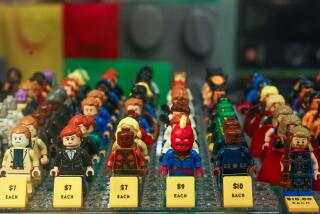Toy train makers on collision course in court
- Share via
Somewhere up in roundhouse heaven, the 19th century railroad barons who fought ruthlessly for coast-to-coast dominance must be shaking their heads over the great modern-day courtroom clash of the toy train titans.
The trade-secret fight between suburban Detroit model-train icon Lionel, once the world’s biggest toymaker but now in bankruptcy, and MTH Electric Trains, formerly Mike’s Train House Inc., has generated reams of court filings and countless billable hours from lawyers over design drawings for model trains. They’re even fighting over puffs of smoke and train sound effects. All of this has dragged on, and on, for seven years.
“This litigation could go on for several years,” said Robert Swift, MTH’s lead attorney. “I don’t see an end in sight.”
Lionel Chief Executive Jerry Calabrese said, “The MTH guys want their day in court, and so do we.”
When that day comes is anyone’s guess. This is an outsized legal dispute to gain the commercial affections of an aging North American universe of model train enthusiasts. Some train collectors describe it as men fighting over toys, but they also note there is big money -- worldwide sales of about $2 billion annually -- at stake in an up-and-down business that holds nostalgic appeal.
Model train collectors hear the rumble of a fatal collision.
“It’s a fight for survival. Whoever loses will probably go out of business,” said Tom McComas, a film producer and model train enthusiast in Michigan City, Ind. “They’re fighting this with the same venom and animosity of the railroad barons, and it’s all over toys.”
McComas, who produced a PBS documentary in 2000 to mark Lionel’s 100th anniversary, said the model train business was dwindling. “The collectors are dying off, and they aren’t being replaced at the same rate.... Kids today don’t grow up with Lionel trains,” he said.
Still, there is money to be made, especially from men over 50 who had Lionel trains as children and now have more disposable income. At the younger end of the spectrum, the June recall of 1.5 million Thomas & Friends wooden railway toys served as a reminder that, as McComas said, “There is still some intrinsic fascination with trains.”
The Lionel-MTH battle stems from a 2000 complaint filed by Columbia, Md.-based MTH, which sued the 107-year-old Lionel, accusing it of selling trains based on designs that had been stolen from a South Korean manufacturer that worked for MTH. In 2004, a federal court jury in Detroit ruled that MTH should get $38.6 million from Lionel, and $2.2 million from another Lionel supplier.
That was roughly 80% of Lionel’s revenue in 2004. The company couldn’t afford to pay. It filed for Chapter 11 bankruptcy and appealed. In December, the U.S. 6th Circuit Court of Appeals ordered a new trial.
In the meantime, both companies are fighting in federal bankruptcy court in New York over how and when Lionel will reorganize and emerge from bankruptcy. That court fight includes a battle over technology that synchronizes puffing smoke and sound effects from trains. A resolution of Lionel’s financial liability on the allegedly stolen designs doesn’t appear close.
Calabrese believes that whatever penalty Lionel has to pay, it will be substantially less than the original jury decision because the appeals court criticized the amount of the penalty.
Attorney Swift said MTH President Mike Wolf was “the quintessential competitor. He’s in this for the long haul.”
Lionel has been in bankruptcy before, but the threat to this privately held company owned by Martin Davis, former Paramount Communications Inc. chairman, and rock musician Neil Young is greater because there is more competition from other entertainment forms.
John Sipple, editor of Model Railroad News magazine, said that the model-railroading hobby had changed dramatically and that Lionel’s allure, described in McComas’ documentary as “a dream weaver for 20th century America,” wasn’t the same in the 21st century.
Sipple said he began playing with trains more than 50 years ago in Geneva, Ill., when “the old guys were railroaders and machinists, and they made the trains from scratch. They made everything that they had.”
“Today, a guy goes into a hobby shop and buys a car ready to go. He doesn’t have time, and that’s how the demographic has changed. People have less time and less space for trains.”
More to Read
Inside the business of entertainment
The Wide Shot brings you news, analysis and insights on everything from streaming wars to production — and what it all means for the future.
You may occasionally receive promotional content from the Los Angeles Times.









